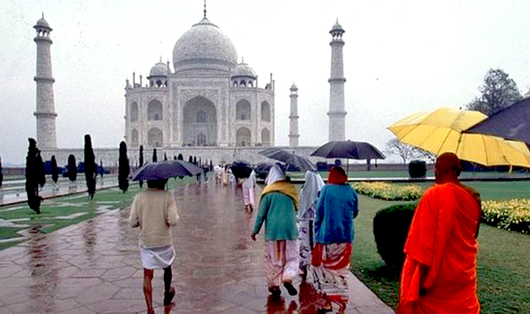Agra (UP), Aug 23: A 60-kg British-era copper chandelier at the main entrance of 17th century Taj Mahal crashed down recently, prompting the Archaeological Survey of India (ASI) to initiate a probe into the matter.
 The six-feet high and four-feet wide chandelier, gifted by Lord Curzon and installed at the Royal Gate of Taj Mahal in 1905, fell down on Wednesday, sources said.
The six-feet high and four-feet wide chandelier, gifted by Lord Curzon and installed at the Royal Gate of Taj Mahal in 1905, fell down on Wednesday, sources said.
A probe under ASI’s superintending archaeologist Bhuvan Vikram has been initiated into the matter, they said.
Though there was no official word as to what caused the chandelier to fall, the sources said it probably came down due to “aging and wear and tear”. “Luckily, there was no one around or else it would have resulted in a major tragedy,” a tourist guide Ved Gautam said.
On Thursday, Agra ASI chief Bhuvan Vikram Singh had said the decision to fix the chandelier would be taken only after carefully examining its structure and its present state.
Meanwhile, some tourist guides have accused the ASI officials of “gross negligence” and questioned their expertise in handling the monument’s artifacts.
E-tickets for night visit
Tourists visiting the Taj Mahal at night would soon be able to buy tickets online till 3 pm of the day of their visit, instead of booking in advance, PTI?reports from Agra.A proposal in this matter has already been cleared and an order would soon be issued, Union Minister of State for Tourism Mahesh Sharma said.
Currently, tickets need to be purchased manually in advance, ASI officials said adding night view is allowed between 8:30 pm to 00:30 am and the duration of visit is 30 minutes.
The night viewing facility is available for five nights, two before and two after the full the moon night.
Arrangements were also being made to allow night-time visitors’ entry to the 17th century monument through the western gate in the compound, the minister said on Wednesday.
Presently tourists for night viewing are permitted entry from the eastern gate, which creates problem for the locals, whose movements gets restricted.Efforts are also being made to develop infrastructure at Mehtab Bagh opposite to the Taj Mahal, so that tourists can see the Taj Mahal at night according to their convenience, tourism ministry sources said.
“A large number of tourists are denied from seeing the Taj Mahal after sunset for various reasons including security concerns,” said K C Jain, president of the Agra Development Foundation, an NGO trying to promote tourism in the city.
“If the facilities are developed at Mehtab Bagh, the visitors would benefit and there would be an additional attraction in the city,” he said.





Comments
Add new comment